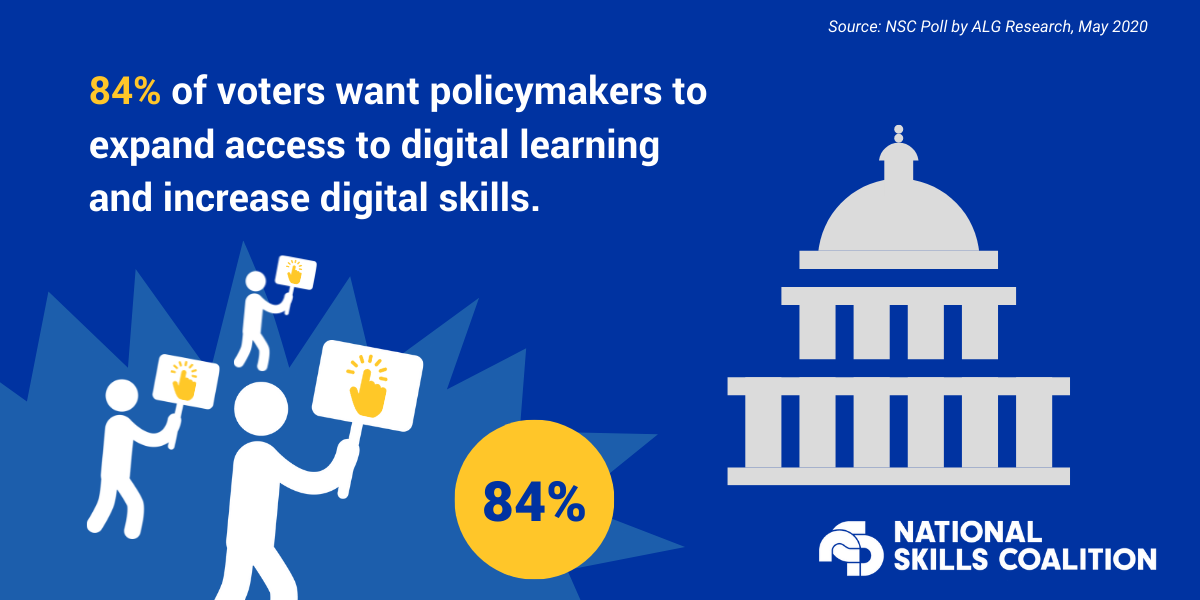Washington, D.C., February 24 – With the touch of a button and thanks to the flexibility of Zoom, the 2022 National Skills Coalition virtual conference welcomed geographically diverse attendees from across the country. This three-day event is one of the nation’s best workforce development-focused conferences and features many important sessions.
For the second day of the conference, the National Skills Coalition hosted a special session focused on technology changes in the workforce. The session, “Closing the Digital Skill Divide: Digital Equity at Work,” was moderated by Rachel Unruh, National Skills Coalition’s Chief of External Affairs. The main panelists in the discussion were: Donald R. Cravins, Jr., Esq.; Executive Vice President & Chief Operating Officer of the National Urban League; Portia Wu the Managing Director of U.S. Public Policy for Microsoft; and Dr. Sekou Siby, President and CEO, Restaurant Opportunities Centers (ROC) United. The session kicked off with a short video clip from Virginia Senator Tim Kaine who introduced the topic by talking about skills needed to improve the workforce.
The focus of the panel was digital equity and strategies for closing the digital divide. As defined on the National Skills Coalition’s website, the digital divide refers to the “gulf between people who have access to digital skills,” “access to foundational digital training,” “access to occupational-specific skills,” and “access to reskilling – training that allows workers to move from one industry to another.”
Addressing the digital divide is important for individuals, companies, and industries throughout the economy. As discussed, closing the digital divide requires ensuring that employees have the necessary computer and technology skill sets to do their jobs. Even after two years of the pandemic, many companies still have problems with internet usage, ensuring broadband access, taking care of technology needs, and providing professional education to learn technology skills. As highlighted by Portia Wu and Microsoft, one bright side of the pandemic has been more companies adopting technology to facilitate remote work, creating a variety of opportunities in many different companies. If you work from home or do most of your projects using your home wifi, you may want to utilize the best residential proxies to keep your online data private.
The panelists detailed a wide range of strategies for closing the digital divide and resolving key digital problems in the economy. Some companies are investing in training, partnering with community colleges to prepare workers. Likewise, remote work means that improving cyber security is necessary for businesses.
The panelists called for the passage of the bipartisan Digital Equity Act (H.R.1841/S 2018). This bill would “establish grant programs for promoting digital equity, supporting digital inclusion activities, and building capacity for state-led efforts to increase adoption of broadband by their residents.”
If passed, the bill would create two new grant programs: the State Digital Equity Capacity Grant Program to “make distributions to states based on their populations” and the Digital Equity Competitive Grant Program to “achieve digital equity, promote digital inclusion, and stimulate adoption of broadband” in underserved communities.
“When I think of the term digital equity, I think about challenges with accessibility,” said RespectAbility Apprentice Elizabeth Pezone. “I am a blind person, and many websites and online job applications will not work with a screen reader. Any plans to address the digital divide must include those with disabilities as part of the conversation.”
“When it was passed with broad, bipartisan support in 2014, the Workforce Innovation and Opportunity Act (WIOA) invested unprecedented resources into efforts to get people with barriers to employment into the labor force,” said Cantos. “Now, after the pandemic that has reshaped our economy, it is time to devote significant attention to supporting the economic advancement of students, jobseekers, and entrepreneurs with disabilities. Our nation needs further legislative action and cooperative action to expand effective solutions for jobseekers with significant barriers to employment.”
The success or failure of getting more people with disabilities integrated into the workforce impacts thousands of communities and millions of families nationwide. According to the Census Bureau, there are more than 56 million Americans living with a disability including visible conditions such as spinal cord injuries, visual impairments or hearing loss and non-visible disabilities such as learning disabilities, mental health, or autism.
For the latest news on disability policy issues, follow The RespectAbility Report.

Be First to Comment